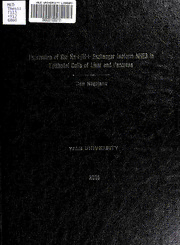
Expression of the Na+/H+ exchanger isoform NHE3 in epithelial cells of liver and pancreas PDF
Preview Expression of the Na+/H+ exchanger isoform NHE3 in epithelial cells of liver and pancreas
YALE UNIVERSITY CUSHING/WHITNEY MEDICAL LIBRARY J Permission to photocopy or microfilm processing of this thesis for the purpose of individual scholarly consultation or reference is hereby granted by the author. This permission is not to be interpreted as affecting publication of this work or otherwise placing it in the public domain, and the author reserves all rights of ownership guaranteed under common law protection of unpublished manuscripts. Date Digitized by the Internet Archive in 2017 with funding from Arcadia Fund https://archive.org/details/expressionofnaheOOnego Expression of the Na+/H+ Exchanger Isoform NHE3 in Epithelial Cells of Liver and Pancreas A Thesis Submitted to the Yale University School of Medicine In Partial Fulfillment of the Requirements for the Degree of Doctor of Medicine by Dan Negoianu 2001 YALE MEDICAL LIBRARY AUG Z 4 2001 (Vlad Lilo T1) 3 4 i I ^ (o^kO 2 Abstract: EXPRESSION OF THE NA+/H+ EXCHANGER ISOFORM NHE3 IN EPITHELIAL CELLS OF LIVER AND PANCREAS. Dan Negoianu, Daniel Biemesderfer, and Peter S. Aronson. Section of Nephrology, Department of Internal Medicine, Yale University, School of Medicine, New Haven, CT. Sodium/proton exchangers (NHE’s) have a major role in cellular homeostasis in virtually all tissues. The sodium/proton exchanger isoform 3 (NHE3) has been shown to play an important role in trans-epithelial fluid reabsorption in the mammalian kidney and intestine. The purpose of the present study was to identify the cellular and subcellular sites of NHE3 expression in hepatic and pancreatic epithelial cells. Three isoform-specific anti-NHE3 monoclonal antibodies were used to label NHE3 in immunocytochemical and immunoblotting studies of rat tissues. In fixed sections of liver, staining for NHE3 was found on the apical (canalicular) membranes of hepatocytes and on the apical membranes of intrahepatic bile duct epithelial cells (cholangiocytes). Labeling of NHE3 as an 80-85 kDa protein was confirmed using an anti-NHE3 polyclonal antibody on Western blots of a hepatocyte membrane fraction enriched for canalicular markers. NHE3 was not detected by immunoblotting of crude liver membrane vesicles, likely because apical duct and apical hepatocyte (canalicular) membranes represent only a very small fraction of the overall membrane population in liver. Staining for NHE3 was observed on the apical membranes of epithelial cells lining pancreatic ducts in fixed sections of pancreas studied by immunocytochemistry. No staining was detected on pancreatic acinar cells. We conclude that the Na+/H+ exchanger isoform NHE3 is expressed on the apical membranes of rat hepatocytes, cholangiocytes, and pancreatic duct epithelial cells, indicating a likely role in mediating transepithelial acid-base and fluid transport across these cell types.
